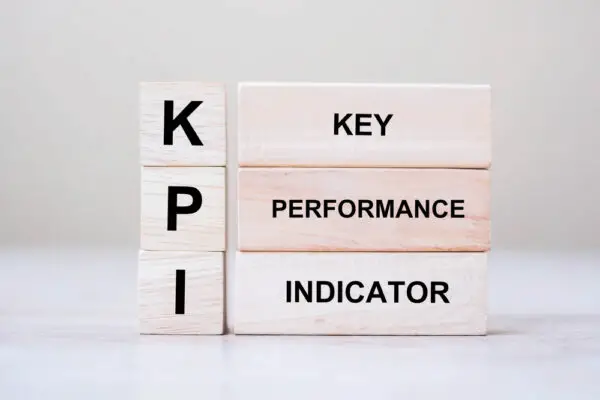You can’t manage what you don’t measure.
Using and developing key risk indicators (KRIs) is beneficial for company line managers, senior management, and boards to assist them in keeping track of the degree of risk in an operation or organization. Modelers can utilize them a ways to incorporate the corporate atmosphere and internal controls into operational risk capital.
The key to an enterprise risk management program is knowing where the risks are, which means collecting data. A good start is with current performance measurements or ‘ideal state. These are called key performance indicators (KPIs).
KPIs are an important part of any improvement initiative because they’re easy to measure and provide a baseline for future progress. KPIs give rise to key risk indicators (KRIs) derived from critical subsets of KPIs that help your organization understand what is happening with its risk management programs.
This blog article highlights the development of key risk indicators, their essential characteristics, and why companies find it difficult to define them appropriately.
Key risk indicators are derived from key performance indicators or might also be derived from organizational policies and standard procedures. The basic objective of using effective key risk indicators or indicators is to measure and eventually improve the performance of an organization.

Best Practices for Implementing Regulatory Compliance KRIs: A Comprehensive Guide
Developing key risk indicators from the existing KPIs is very important, but organizations often find this task difficult. This is because selecting meaningful KPI subsets out of the set of available KPIs can be quite complex.
The main challenge in KRIs design is having a clarifying role and an actionable application in an organisation context. KRIs are not only used to measure performance but also to identify and manage potential risks, issues and . Hence, they need to capture both the severity of threats and the likelihood of their occurrence.
Risk Management
Risk management enables risk exposure to risk events giving rise to monitoring risks in a risk register. The risk exposures from existing metrics through periodic and regular reviews to monitor risks and the performance of early warning in a timely manner in decreasing costs during the economic downturn.
The financial kris trigger points in increasing revenues for many organizations setting thresholds due to regulatory changes
Data on many organizations with different indicators of the company’s goals and kri values measure kri risk thresholds on the right metrics focusing on the likelihood of high staff turnover events in various areas and tools that monitor different measurable data on the security breach.
Risk appetite framework leveraging technology at the same time thorough understanding of the same coin of performance management as a measure of a good key performance indicator or risk indicator during an internal audit of operational risk management.
Key control indicators that have risk exposure indicators for performance management and monitoring by use of tools that are measurable and monitor performance management.
Developing your Key Risk Indicators (KRIs)
Enterprise risk management (ERM) is a way of determining risk landscape the assessment risk reporting and mitigation of risk. ERM asks organizations to develop various indicators that show the risks they pose.
These benchmarks are termed “key risk indicators” or KRIs. The KRIs serve as warning devices for potential risks across many areas, e.g., business units. Similar to KRIs, KPIs are metrics that give an overview to show an organisation’s effectiveness.
KPIs and KRIs are similar in that they analyze and improve efficiency and productivity. On the other hand, KPIs use a different approach to measure and achieve corporate goals. Management decisions may be improved by effective KPIs and KPIs, which can help generate practical action plans against them.
Practical actions that need improvement of controls will be better monitored when reviewing the same metrics in different timeframes.
This allows for a better understanding of risks to overall organizational change management because the evaluation of KPIs will illustrate their uniqueness and how they work together compared to other areas across the company.
How do I Develop Key Risk Indicators (KRIs) to Fortify my Business
The identification and assessment processes should be iterative and dynamic. An auditor must review & document the and modify resiliency responses and inspection procedures as the situation changes.
Risk indicators (KRIs) assist companies in avoiding specific sorts of risks that might prevent them from carrying out their planned activities. Risk adjustments to complex situations are assessed and changed. It is critical to obtain accurate and thorough information on any such risk mitigation response for your company’s success plan. Risk assessment is a type of threat indicator.
The first step is identifying potential threats that might directly or indirectly affect your company’s profitability, reputation, or success. This may be easy for some companies who experience more dramatic events in their space than others, so identifying these threats will depend on the nature of your business.
There are three stages of KRI distribution – distribution within executive-level risk management teams, distribution to middle managers responsible for specific lines of business, and distribution among employees. It’s important to clearly define what role everyone has in terms & methods of analyzing risks.
Identify the KRIs relevant to them by collecting information from previous risk assessments and conducting brainstorming sessions with all relevant stakeholders concerned about managing key operational risks within their organization.
Risk Indicators: Examples & Definitions
Risk indicators are the specific points on an organisation’s horizon that should be used as a warning sign of pending danger.
Organizations should actively look for and utilize these signs to prevent major risks from permanently impacting financial performance programs and other business metrics.
A risk indicator is something within an organization that warns of possible future problems. Examples include poor-quality indicators such as data breaches as increasing inventories, increasing errors in quality control, increasing amounts of work in production, declining labor effectiveness, and excessive inventory requiring high investment costs or high carrying value such as obsolete or slow-moving items.
Businesses are increasingly looking to indicators beyond financial’s to measure performance. Reporting on the risk indicator is also mandated by laws, providing cause for more corporations to do so.
One way of measuring these assorted risks is through the indicator of insolvency risk. The insolvency risk, or the financial stability risks that an organization faces if it fails, can be calculated using two numbers—the current liquidity ratio and the quick ratio.
The current liquidity ratio measures how much cash a company has compared to its short-term assets (such example – as inventory).
It can provide insight into whether a business will have enough cash over the next 12 months to cover expenses. On the other hand, the quick ratio examines whether or not there is enough cash to cover the more pressing expenses.
A key indicator for assessing management tenure is the turnover rate. Generally speaking, turnover rates above 20% may be a reason to take notice and investigate potential factors driving this high level.
Examples of this might be productivity levels; failure demand accepted ratio; warranty expense ratio; idle capacity utilisation ratio; and power outage expense ratio.

How To Use A Common Set Of Key Risk Indicators
Why Do I Need Them?
Key Risk Indicators help you understand more about an organisation’s financial position. It also helps management see what segments of the company are more vulnerable under different scenarios and possible recoveries.
They show, at a glance, what is happening with any given project for future projects, like: will we end up investing in this or that future project? Does it provide benefits now or only in the long run? What investors do we want on board today? Is there an incentive plan with the associated consequences (e.g., if current employees leave)?
In any procedure, key risk indicators are critical. These are essential data when making vital judgments and focusing on the most significant risks pressing risks.
KRIs may highlight the urgency of certain risks and assist with staff training in protecting and managing them. They also validate and improve risk assessment methodologies in a variety a types of settings.
Lastly, they can assist with budget planning and the organization of a firm’s priorities based on changes. Every project requires KRIs because they improve the risk culture within the company. They may highlight the significance of security, and risk mitigation strategies, and risk management. Indicators also assist in identifying emerging risks
How Do you Design Them?
Developing a is an essential task for any business. The objective of designing a key risk indicator is to derive and manage the most most significant risks and factors that affect their success.
Identifying your key risks will protect you from unforeseen events and give you insights into what could happen if things go wrong at different levels of your company.
Developing an effective risk management strategy requires many total industry sectors to collaboratively develop strategies against particular risks.
This collaboration might include members within personnel, shareholders, or an emphasis on investor relations depending on the company’s size to reduce organizational stress across departments.
Develop and maintain a set of key risk indicators that can be monitored periodically to give management insight into actual and potential risks. These key risk indicators examples should be based on feedback from the organisation’s various constituencies, such as customers, employees, suppliers, or regulators.
Key risks should be identified, tracked, and properly handled proactively before they become too big or costly to control effectively.
The key to good decision-making process is good information – specifically, timely information about your company’s assets and how risk correlates with each asset class.
You’ll need information about threats to these precious resources, which can take many different forms in magnitude, sources (from inside or out), frequency of occurrence (regularly? rarely?), strength (persistent?), and the potential impact on performance.
Developing any toolkits can help detect risks that have been identified previously or currently. Find out what triggers this and when it happens, so the closer we get to where it comes from, the easier our choices will become!
You may use this analysis as a manager to determine mitigation tactics against these potential disasters before its too late-functioning not just on an individual level but also across groups if need be
How do I Identify Key Risk Indicators?
Developing a strategy for establishing a KRI framework is the first step in identifying KRIs. This procedure involves your risk management team, each business division, and individuals responsible for internal reviews.
The key risk indicators you should pay attention to vary depending on the type of business you operate. You need inventory monitoring for those businesses that sell goods, market analysis to see trends and the competitors’ activity (so as not to be blind-sided) for those in marketing,
and environmental obligations – such as CO2 emissions – for those operating within regulated markets. If only one or two of these apply to your business, then it’s less important than if all three apply, and your thinking and planning should reflect this (more appropriate resources will be needed). The first step is identifying what applies to you. From there, identify different points where risk can occur within each area.
There are both qualitative and quantitative indicators of risk. Qualitative indicators manage risk can be ‘soft’ in nature, such as the quality of management compared to its peers or investor sentiment, or more direct in nature, such as credit rating. Depending on volatility needs, qualitative factors may entail less time with value at risk calculations than quantitative indicators with the same maturity date.
Quantitative measures rely on observable market data to assess their degree of vulnerability with respect to an investment’s potential risks. Investors use various quantitative approaches to measure the degree of exposure or sensitivity to certain risks by quantifying key relevant economic variables according to a security’s sensitivity profile.

Key Credit Risk Indicators
Why Do Organisations Struggle with KRIs?
The reason is that they ignore the (KRIs) that are valuable in gaining insights into how valuable their investments are. Organizations need a balance between cost, time, and budget.
They must set up key performance indicators for success to measure what has been done. The goal is not to avoid risk but to reduce it by acquiring foresight, visibility, accountability, and early warning signals for risks and opportunities.
Organizations struggle with KRIs because people are too focused on financial performance to see what truly impacts an organization. It’s about meeting your expectations, not about making a profit sustainably. Financial statements are important, but they don’t capture the qualitative aspects of that company or organization.
Organizations struggle with KRIs – key risk indicators – because strategic leadership must be strategic in their actionable response to external and internal risk factors.
Many leaders makes the mistake of looking too much at tactical approaches, which is a reactive approach that usually only works short-term.
For organizations to be successful, they need to rethink, rewire, and recalibrate their strategies to mitigate risks instead of simply responding when they come proactively.
This also allows them to proactively monitor how changes can affect business goals or organization vulnerabilities, an important sign that something needs to change before a crisis hits. Good business leaders a keep a long-term view of where their organization should go by periodically assessing key strategy questions.
Many organizations have yet to allocate all the necessary resources. It is important to choose software to protect your data and not worry about it. Most businesses lump the key risk indicators, often called “red flags,” with the crucial performance metrics.
For example, a bank may be expanding its client base to increase income, but it can also grow due to delayed accounting periods outside of its control.
Relation of KRIs to KPIs(key performance indicators)
Key risk indicators are at the core of our company; they measure an institution’s irresponsibility level. We have found that KRI’s can often give us a better approximation for future failure rates.
It is important to note that not all KRIs are KPIs, but it is generally good practice to make a list de them so if possible. It creates a clearer picture of what your company’s future earnings would be like.
Key Risk Indicators (KRIs) are the ongoing measurements of the scariest, most predictive risks a company faces. KRIs provide a benchmark for ongoing monitoring and predictive analytics to identify changes in people, processes, or technologies that have the potential to hurt your KPIs.
KRIs ties analytical work to the organisation’s strategic planning goals and facilitates root cause analysis for ongoing improvement initiatives.
KRIs improve your KPIs by keeping you from focusing on less important items without addressing more foundational root causes. Managing strategic risks is different from managing operational risk – it requires discipline, experience, and deep resources well beyond those required
Key performance indicators are crucial to achieving a company objective. You should almost certainly track key performing indicator(s) when it comes time for your business objectives and strategy because they provide important data that will help you measure the success or failure of any given plan—if there is one at all!
Tracking KPIs also allows managers an early warning system so if something goes wrong with them, changes can be made before things get even worse than expected.
How do Key Risk Indicators Help Companies Identify Emerging Risks?
Key risk indicators are raised when a company observes that its pre-determined tolerance limits have been breached by time or changes to market conditions.
Risk managers establish these limits in collaboration with operational managers and perform continual monitoring to uncover areas where the limitations were continually exceeded or not reached.
Key risks cover any deviations from what might be expected from acceptable business operations, either positively or negatively, so they essentially serve as milestones for monitoring progress and gauges of success-failure criteria for weighing our self-assessment.
-Specific to the company: Identifying and tracking key financial and non-financial indicators will allow companies to spot patterns and changes in risk areas. Understanding what affects the P&L, debt levels, and return on assets can help identify where risk might emerge or grow under current risk management strategies.
-A single organization cannot look at only its risks without considering how they will affect other organizations. Companies need to work together to don’t contribute significantly more than their share of total organisational risk across the sector.
Risk is most effective when many different sources contribute small amounts so that it’s not just one organisation taking on too much burden.
Today, the government and pharmaceutical companies will begin a new round of pandemic . Other sectors will focus on improving or establishing their procedures.
KRIs assist in identifying and defining risks by linking each KRI to possible hazards. Companies may also examine the dangers that arise when employees work remotely and in cyber security.
The KRIs are a valuable instrument for organizations seeking to manage their risk. They aid in the detection of critical risk events for businesses.

wooden cube block with KPI (KEY, Performance and Indicator) word on table background. Business concept
Designing Effective KRIs
Key risk indicators are the leading indicators of forwarding movement for an organization. Examples of key risk indicators include safety, cost, or compliance.
Many organizations rely on monthly safety meetings to identify potential risks and plan to mitigate them before a situation becomes a crisis.
A good way to ensure continued progress is to measure your efforts against a standard benchmark for what constitutes a “good” month going into the next meeting with your committee – that will give you feedback as you go along, provide focus in your work and continually improve your processes ’til finally achieving success!
A mapping exercise may help you design effective KRIs. The first step is to define your mission – increase profits. Then you must figure out how to enhance earnings, cut expenses, or improve returns.
Numerous approaches can achieve almost any path, but your team may choose the most realistic approach to boost income or reduce costs.
This route allows managers to maintain an eye on the most important KPIs without accumulating many data points or data. A rise in product pricing in this manner might help you increase sales, but it may also result in customer churn and loss of your competitive market position.
Chris Ekai is a Risk Management expert with over 10 years of experience in the field. He has a Master’s degree in Risk Management from University of Portsmouth and is a CPA and Finance professional. He currently works as a Content Manager at Risk Publishing, writing about Enterprise Risk Management, Business Continuity Management and Project Management.

